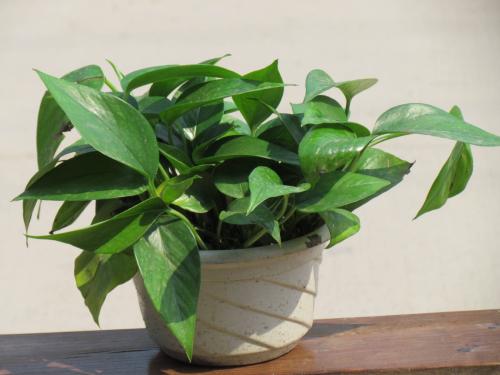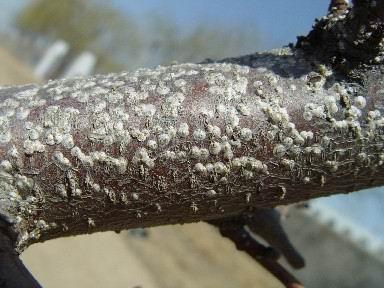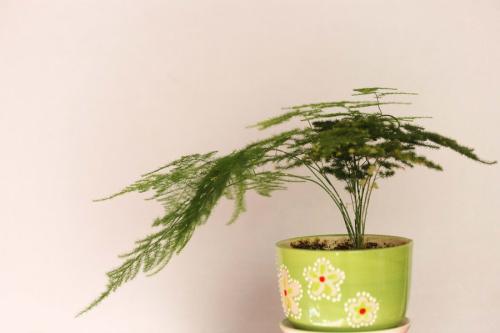The effect of green radish breeding methods and precautions, green radish leaves yellow picture is what causes
Green pineapple is a common interior decoration plant in the home, which is green and evergreen all the year round, whether it is placed in the living room, study or hanging at home, this touch of green freshness can not only bring people a sense of aesthetic pleasure. And it has a lot of functions.

1. Purify the air
In addition to the ornamental value, the most important thing of green pineapple is to purify the air! How strong is the green pineapple to purify the air? According to the research of scientists, a pot of green apple is equivalent to an air purifier in a room of 8 square meters. It can be seen that the air purification capacity of green pineapple is quite strong, planting green pineapple at home can save the money of the air purifier!
2. Ventilation and ventilation
In addition, green pineapple also plays a role in indoor ventilation, because green pineapple can absorb carbon dioxide and exhale oxygen. If you put it in the window, when the wind is strong outside, the green turnip will block the wind; when there is no wind, the green apple respiration will release oxygen, which will make the space where we live more fresh.
3. Impurity adsorption
For people who have just decorated a new house, many harmful gases in the new house are a great headache. In addition to making the newly decorated new house more ventilated, you can also put several pots of green pineapple, which can absorb benzene, trichloroethylene, formaldehyde and so on in the air, so it is very suitable to be placed in the newly decorated bedroom.
Culture methods and matters needing attention
Since green pineapple has so many functions and functions, how to breed it? What are the matters needing attention in the process of breeding? The following is based on the understanding of light, temperature, soil, watering and fertilization needed for plant breeding.
1. Soil
The pot soil for the cultivation of green pineapple should be mixed with 3 rotten leaf soil, 3 garden soil, 3 river sand and 1 barnyard manure. The soil of green pineapple is as fertile as possible, because most of its nutrition comes from soil. Try to choose some soil in the field, mix the soil with animal droppings, and put some fine dead leaves in the soil.
In addition, green pineapple likes soft soil, withered leaves and feces play a role in increasing soil fertility, softness and ventilation.
2. Lighting
The original growth condition of green pineapple is in the forest sheltered by towering trees, and the positive direction is not strong, so direct sunlight should be avoided and should be maintained under the condition of semi-shade or scattered light, but in the north of autumn and winter, in order to supplement the deficiency of temperature and photosynthesis, but its illuminance should be increased.
Green pineapple can be placed all the year round in the sunny place indoors. In darker rooms, it should be moved to a strong light environment every semimonthly to restore for a period of time, otherwise it is easy to make the internodes grow and the leaves become smaller.
3. Temperature
In the north, the green pineapple can survive the winter safely when the room temperature is above 10 ℃, and the green pineapple can grow normally when the room temperature is above 20 ℃. In general, it is not a big problem for families to reach this temperature, we should pay attention to avoid excessive temperature difference, and at the same time, we should also pay attention to the leaves not close to the heating equipment.
4. Watering
Green pineapple likes to be wet, and the basin soil should be kept moist in spring, summer and autumn. Watering should be controlled in winter, and the basin soil should be watered again after it is dry; on the contrary, too much watering and too wet basin soil will reduce the cold resistance and cause yellow leaves and rotten roots. In winter, the leaves can be sprayed with warm water every 3 to 5 days, and the amount of water should be controlled between 1 ax 4-1 pm 2 to keep the leaves bright and green.
Generally, water is watered every 2-3 days in spring and late autumn, and once a day in summer, and water is often sprayed on the leaf surface and the ground around it to increase air humidity and make the leaves bright green.
5. Fertilization
Green pineapple grows faster, and topdressing should be strengthened in the growing season. Topdressing should be based on nitrogen, and nitrogen, phosphorus and potassium fertilizer should be applied together. In autumn and winter in the north, plants grow slowly or even stop growing, so fertilization should be reduced. Before winter, liquid inorganic fertilizer is mainly sprayed. After winter, fertilizer is mainly sprayed on the leaf surface, mainly sprayed through the stomata on the leaf surface, and the fertilizer is absorbed through the stomata on the leaf surface. The fertilizer effect can act directly on the leaf surface.
Topdressing is applied every 10 to 15 days from spring to early summer; the Summer Solstice is topdressing every 20 days in early autumn; and every 10 to 15 days in autumn; instead of topdressing the basin soil in winter, it is only necessary to spray leaves with 0.1% 0.2% urea solution every 20 to 30 days to make the leaves green and bright.
Matters needing attention
(1) the leaves turn yellow and fall off, and the stems rot: mainly due to too much watering, especially in winter. Green pineapple requires good permeability of basin soil and avoid stagnant water in the basin. If you find this situation, you should change the basin in time.
(2) the leaf tip is curled and brown: mainly because the air is too dry, it should be sprayed to the leaf surface frequently.
(3) the leaf margin turns brown and withered yellow spots appear on the leaves: they are not watered enough in the growing season and the basin soil can not be completely dried before watering. Totem pole plants should be careful to wet the posts when watering, because some roots grow on the posts.
(4) the leaves become smaller: green pineapple must always keep the top and grow upward when it is cultivated as a totem pole, as long as it bends downward, the leaves will gradually become smaller; fertilizer or light is insufficient.
(5) the leaves become soft and curved, and the stems rot: due to the low temperature, the green pineapple is very sensitive to the low temperature below 10 ℃.
Green pineapple leaves turn yellow
Green pineapple is prone to yellowing in the process of culture, which has a lot to do with improper culture methods. According to the yellowing of leaves, we can see which breeding step has gone wrong.
1. Withered and dry yellow on the edge of the leaf-lack of water
If the leaves of the green apple are withered and yellow, the leaves will fall off, but the new leaves grow well, which is likely to be caused by the lack of moisture in the green apple soil.
2. The liquid surface is dark and yellow without luster-too much watering
If the leaves are dull and yellow, or even the roots rot, the new branches shrink, indicating that they are overwatered, so stop watering at this time and loosen the soil appropriately.
3. The new leaves are yellow-the light is dim.
If the green pineapple is placed in a dark and unventilated place for a long time, then the green leaves will be yellow due to the lack of chlorophyll, especially the new leaves will be yellow, at this time, the green pineapple needs to be placed in a cool place with sufficient light.
4. Leaf wilting-direct sunlight
Pineapple grows in a cool environment, so if the green pineapple is exposed to strong light for a long time, it is easy to cause the leaves to wilt and wither, and then turn yellow and fall off. At this time, you need to put the green apple in a cool and bright place and water it properly.
5. Yellowing of roots and leaves-insufficient fertilization
Green pineapple is lack of nutrition, when insufficient fertilization, it will cause the color of the leaves to gradually fade to yellow, especially the leaves on the roots will first yellow and fall off. At this point, more fertilization is needed.
6. The leaves curl up and do not stretch-too much fertilizer is applied
When the green pineapple is fertilized too much, the leaves are thick but not glossy, the leaves curl up and do not stretch, and the old leaves turn yellow and fall off.
Time: 2019-05-05 Click:
- Prev

How do scale insects and their species identification come from? Are plant scale insects parasitic and harmful to humans?
The shell insect is a kind of small insect, and it is also one of the pests that many fruit growers and flower friends hate extremely. It mainly harms fruit trees and trees, and is one of the most common pests on flowers. Its reproductive ability and drug resistance are very strong. It is generally difficult to control or eradicate how shell insects come from.
- Next

What are the breeding methods and matters needing attention of asparagus? Diagram of salvation method for yellowing leaves of asparagus
In life, in order to make the indoor air fresher, many people will choose to put green plants at home, which can not only be beautiful but also play a role in purifying the air. Asparagus is very popular because it is graceful, elegant and chic, and relatively short, which is suitable to be planted at home as a potted plant.
Related
- Fuxing push coffee new agricultural production and marketing class: lack of small-scale processing plants
- Jujube rice field leisure farm deep ploughing Yilan for five years to create a space for organic food and play
- Nongyu Farm-A trial of organic papaya for brave women with advanced technology
- Four points for attention in the prevention and control of diseases and insect pests of edible fungi
- How to add nutrient solution to Edible Fungi
- Is there any good way to control edible fungus mites?
- Open Inoculation Technology of Edible Fungi
- Is there any clever way to use fertilizer for edible fungus in winter?
- What agents are used to kill the pathogens of edible fungi in the mushroom shed?
- Rapid drying of Edible Fungi

